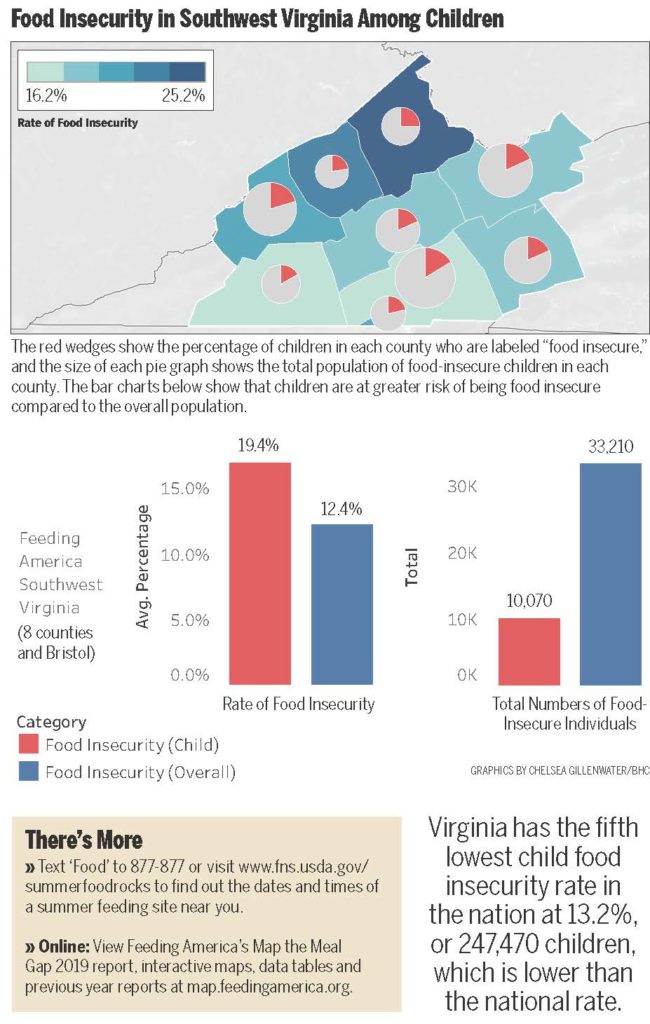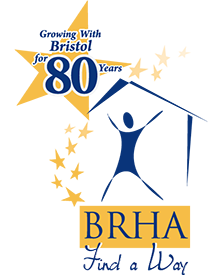From a recent article in the Bristol Herald Courier, it is reported that Virginia has the fifth lowest child food insecurity rate in the nation at 13.2%, or 247,470 children, which is lower than the national rate.
Full article available here: https://www.heraldcourier.com/news/more-than-children-in-southwest-virginia-face-food-insecurity/article_83c11330-c9c8-59c1-932d-0623b1253267.html

Economic factors that generally contribute to food insecurity are unemployment, low wages, medical conditions, drug abuse, debt and lack of transportation and affordable child care options that force individuals and families to skip meals or eat cheap, unhealthy food.
And rural areas — where there aren’t many nearby grocery stores, food banks or civic organizations where food donations can be bought or picked up — tend to have higher food insecurity rates.
The summer months and child hunger
Across the nation, 22 million children and teens receive free and reduced-price meals at schools during the academic year, according to the USDA, but only about 3.7 million participate in the department’s summer meal programs.
The USDA’s Summer Food Service Program and Seamless Summer Option of the National School Lunch Program help fill the “critical nutrition gap” of children 18 years old and younger, a news release from the USDA states.
A recently released study of the SFSP by USDA, based on 2015 data, found that schools were the most common setting for meals service followed by recreation centers, parks and playgrounds, churches and community centers. Sixty percent of sites offer breakfast and 14% offer dinner in addition to lunch, according to the study.
The child food insecurity rate in both Russell and Tazewell counties is 18.2%, each at around 1,000 children.
This is the third year the Cumberland Plateau Regional Housing Authority is offering food in partnership with Feeding America Southwest Virginia through the USDA’s program. Lunch and an afternoon snack are provided Monday through Friday.
In 2018, it lasted for 10 days, during which 144 lunches and 136 snacks were served, with the majority of children served being younger than 10, according to the authority’s Resident Service Coordinator Paula Culbertson.
“While the meals program is certainly helpful to and appreciated by our residents with children, the activity session also draws folks in, as we aim to keep our youth engaged in positive activities during summer break,” she said.
Russell County Public Schools, also through USDA’s summer program, is serving free breakfast and lunch to kids 18 and younger Monday-Friday at all of the elementary, middle and high schools except Copper Creek Elementary through July 12, excluding July 4-5. Adult meals cost $2.
Washington County Public Schools is operating its USDA program for the second consecutive year this summer.
“The county hadn’t done summer feeding in several years so we know there’s a need in our community,” said Valerie Cupp, coordinator of school nutrition.
Last summer, there were two feeding sites, and the program was expanded to five sites this year to reach more areas of the county. Those sites are Patrick Henry and John S. Battle high schools, Hayters Gap Library, Emmanuel Baptist Church and Sugar Hollow Park. Adults can also eat for $3 per meal.
Cupp said the plan is to expand into a couple of other parts of the county next summer.
Working together
Bristol Virginia Public Schools School Nutrition Program Director Kathy Hicks and Feeding America Southwest Virginia CEO Pamela Irvine attribute Virginia’s success in addressing child hunger to former First Lady Dorothy McAuliffe’s efforts to bring agencies, organizations and federal and state departments together to implement the Virginia 365 Project to End Childhood Hunger.
In 2015, USDA provided $8.8 million in funding to the state to test the impact of providing three meals a day to all children in select schools during the school year, food for weekends and school breaks and more resources for low-income households to purchase food during the summer months, according to USDA’s website. Born out of that was the Virginia 365 project. The cities of Bristol, Galax and Richmond as well as Buchanan, Grayson, Lee, Scott, Smyth and Tazewell counties were chosen for the project.
Hicks said Bristol’s school system was the first in Southwest Virginia to implement the program and while it was a success, it ended with the 2018-19 school year, and despite progress, there are still some kids who aren’t getting enough to eat during the summer.
“Parents don’t have transportation, even though the meals are provided at the sites,” Hicks said.
If those at Feeding America Southwest Virginia receive a grant they’ve applied for, the plan is to partner with the school system next summer to provide a mobile food truck, out of which hot meals or pre-packaged meals will be served, she said.
Under other federal year-round funding for which the school system qualifies, breakfast, lunch and dinner will continue to be served at five schools during the upcoming school year and summer feeding is underway.
In the first couple of weeks of the summer feeding program this year, 5,000 meals were served but there could still be many children who aren’t getting enough to eat because more than 2,300 students are enrolled, Hicks said. Meals are being provided at four schools, the Bristol Public Library, the Boys and Girls Clubs and Girls Inc. on varying days and times.
Hicks and Irvine said the Southwest Virginia Coalition to Address Hunger Free Children was formed in anticipation of the Virginia 365 project ending to find funding and strategize to continue ensuring children don’t go hungry.
So far, the nonprofit and school system are members as well as some schools or systems as a whole in the city of Galax and Buchanan, Grayson, Lee, Smyth, Tazewell, Wise and Wythe counties.
“We’re in the discovery phase of that now in determining what response is realistic to fill that need because it’s going to leave a great gap for those children and a lot of those areas don’t have the resources to be able to provide a lot,” Irvine said. “That’s why we are going to invest and increase our children’s’ programs next year in those communities, at least by 10, if not more, sites.”
Feeding America Southwest Virginia has partnered with 11 sites to offer summer feeding programs. The plan is to add 10 more sites next summer, Irvine said.

